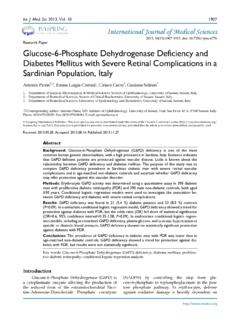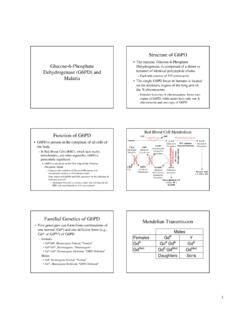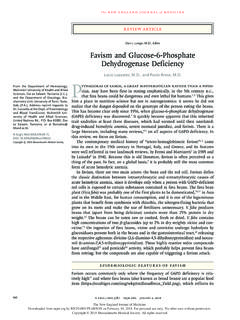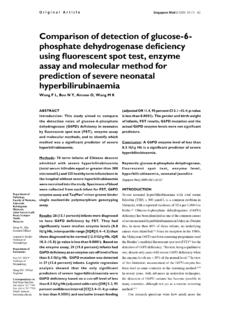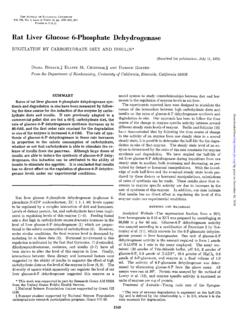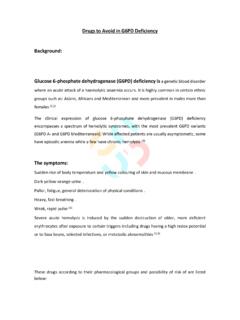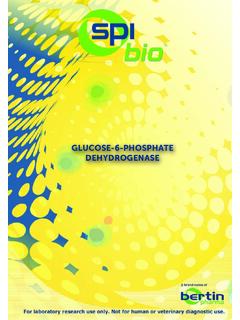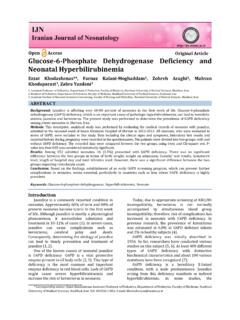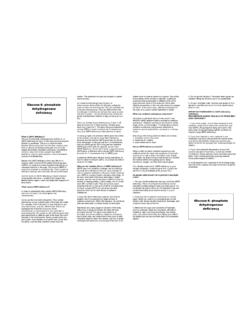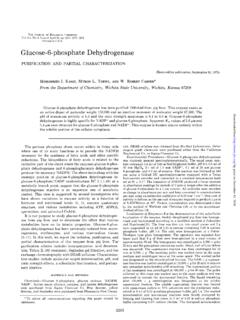Transcription of Glucose-6-Phosphate Dehydrogenase (G6PD) Deficiency
1 2G6PD DeficiencyGlucose-6- phosphate Dehydrogenase ( g6pd ) is an important element (enzyme) in the glucose oxidation (oxygen utilization) process of red blood cells (RBCs) and for maintaining their normal life span. g6pd Deficiency is an inherited disorder caused by a defect or Deficiency in the production of that enzyme. Consequently, g6pd Deficiency may cause the destruction of RBCs leading to a condition known as hemolytic anemia in which the body cannot compensate for the destroyed cells. In this condition, the patient may show jaundice (pallor, yellowing of the skin, and discoloration of the eyes), dark urine, fatigue, shortness of breath, and a rapid heart rate.
2 Many patients, however, remain without symptoms. Sometimes severe hemolytic crisis in individuals with g6pd Deficiency require immediate medical Deficiency is the most common human blood enzyme Deficiency affecting about 400 million people worldwide. The highest prevalence rates occur in areas where malaria is common, such as: tropical Africa (20% of the population are affected), the Mediterranean (4-30% are affected), tropical and subtropical Asia, and Papua New Guinea. However, the severity of the disease varies among populations with the milder form being common in Africans, while the most severe form is found in Mediterraneans and South East FactorsGenetic: Mutations in the g6pd gene, located on the X chromosome, are responsible for causing the disease by reducing the amount of g6pd enzyme in the blood or altering its structure.
3 Males inherit one X chromosome from the mother and one Y chromosome from the father. Since the mutation affects the X chromosome, it cripples the only copy capable of producing the g6pd enzyme, resulting in more severe symptoms. Females, on the other hand, inherit two X chromosomes, one from each parent. A mutation in one copy is compensated for by the presence of the other healthy copy of the gene. As a result, many females are carriers of the disease and do not present any clinical symptoms. However, in the rare case when a female receives two defective g6pd genes, the hemolytic anemia becomes as severe as in the affected male. Interestingly, carrier females for g6pd Deficiency are more resistant to malaria than normal non-carrier females and, hence, the high prevalence of g6pd Deficiency in areas that were, or still are, endemic for : Hemolytic anemia associated with g6pd Deficiency is usually triggered by bacterial or viral infections as well as by certain drugs.
4 Also, eating fava beans or inhaling pollen from fava plants increase the breakdown of RBCs in susceptible individuals, thus, leading to a condition known as and ManagementSome, but not all, newborns with g6pd Deficiency are recognized because of jaundice occurring soon after birth. Among many affected males, the condition remains asymptomatic and the signs and symptoms of the disease may appear at any age only after the intake of fava beans or certain due to g6pd Deficiency is best prevented by excluding fava beans from the diet as well as avoiding certain antibiotics ( , Sulphonamides, Nitrofurantoin, Dapsone), anti-malarial drugs ( , Quinine, Chloroquine), anti-cancer drugs, and other drugs such as Aspirin and 3 HemophiliaSickle Cell ThalassemiaThrombophiliaG6PD g6pd DeficiencyHydralazine.
5 In severe hemolysis, blood transfusion may be Deficiency in Arab PopulationsG6PD Deficiency is a common genetic disorder in almost all Arab countries due to the high frequency of the abnormal gene in conjunction with the high consumption of fava beans in the region. The prevalence of the disorder varies widely in different parts of the Arab World. A very high frequency of g6pd Deficiency has been recorded in Saudi Arabia among male and female newborns (37% and 21%, respectively). Studies indicate that about 20-25% of males in Bahrain and Oman have this disorder. In other Arab countries, g6pd Deficiency occurs at relatively low to moderate rates: Jordan (3-12%), UAE ( ), Iraq ( ), Yemen (6%), Libya (2-3%), Tunisia ( ), Lebanon ( ), and Egypt (1%).
6 Genetic studies conducted in Algeria, Iraq, Kuwait, and UAE have demonstrated that the Mediterranean type of g6pd Deficiency occurs more commonly in patients in the Arab World. In the UAE, 80% of the g6pd deficient cases carry the Mediterranean variant, which results in more severe symptoms than other g6pd variants, due to an unstable enzyme and less than 1% of enzymatic activity.
